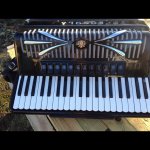N
nathen
Guest
When I switched from playing the piano for umpteen years to the pa, my instructer warned me that the pa was not to be mistaken for a small piano. They are two completely different instruments. The piano is a percussion string instrument. When the hammer hits the string the note starts to fade, the fingers are then free to move to any other note, consequently the thumb doesn't have to be used for black keys.
The pa (on the other hand, no pun intended) is a reed instrument, and the note will continue as long as air is passing through it. Plus it can be louder or quieter depending on bellows pressure, making expression much more subtle than percussion instruments (my opinion).
Therefore there is a need to move away from the strict rules of piano fingering. For example, when playing a chord and holding it, the thumb can play other notes as harmony, wheras with the piano the whole hand is available. So the pa need a different approach to treble fingering. There is a need for more creative fingering than the piano, given the sustaining note ability of the pa.
There, now I've thrown in my ten cents worth!!!
Nathen
The pa (on the other hand, no pun intended) is a reed instrument, and the note will continue as long as air is passing through it. Plus it can be louder or quieter depending on bellows pressure, making expression much more subtle than percussion instruments (my opinion).
Therefore there is a need to move away from the strict rules of piano fingering. For example, when playing a chord and holding it, the thumb can play other notes as harmony, wheras with the piano the whole hand is available. So the pa need a different approach to treble fingering. There is a need for more creative fingering than the piano, given the sustaining note ability of the pa.
There, now I've thrown in my ten cents worth!!!
Nathen

